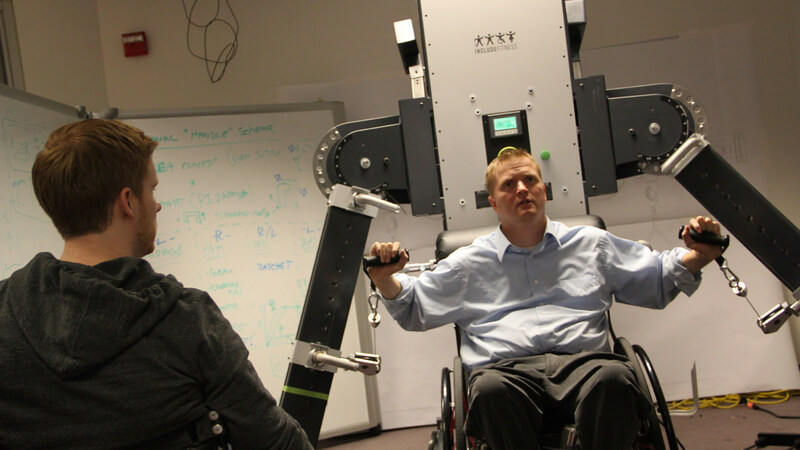

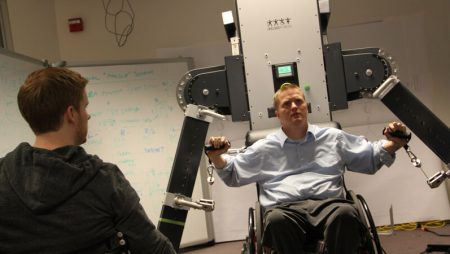

Get new exclusive access to healthcare business reports & breaking news




Despite accounting for 18% of our country’s GDP, the healthcare industry has undergone very few digital innovation initiatives over the last decade. When I started working on healthcare innovation in 2012, I knew I was embarking on an uphill battle of biblical proportions.
Recognizing the slow, small transformative steps in the industry, any innovation in this field, whether from inside or outside, should be praised and shared with the world so others get encouraged to continue the effort.
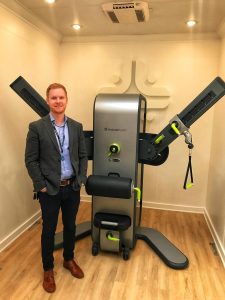

Ryan Eder, CEO of IncludeHealth. In the background – the Access Strength Fitness Equipment that is redefining fitness as we know it
Employing a combination of hardware, services and solutions, Ryan Eder and his company IncludeHealth, are redefining the fitness and wellness industry. Put bluntly, IncludeHealth is literally rebuilding the fitness industry – from the ground up.
When I met Ryan, he was attending a major healthcare conference where he was showcasing his next generation cloud-enabled platform and his stunning proprietary fitness equipment (more details below). And, IncludeHealth had just won its 25th industry award as one of the 10 best Sport Medicine Technologies of 2018. Although IncludeHealth operates in a very small corner of the humongous 3.5 trillion dollar healthcare industry, Ryan’s story is applicable to other disruptors and visionaries in the healthcare space.
I would even say that if other healthcare executives applied the same principles to product development that Ryan does, had the same passion for what they did, and possessed the same forward-looking vision towards their products, we would all have a much better chance of propelling the whole industry into a more relevant future.
Before going into details about what it took to build this amazing platform, let’s take a look at what is IncludeHealth.
The IncludeHealth solution has a hardware and a software component. Each is equally revolutionary and critical to the success of the company.
First, is the most versatile piece of physical equipment the world has ever seen, with two independent arms that rotate 180 degrees allowing people of all ages, disabilities and strength levels to smoothly operate the machine. Users program the machine, choosing from hundreds of upper and lower body exercises using weights, seat and arm heights that are automatically adjusted based on the online-planned workout session. Users can use the machine while seated, standing or even while in a wheelchair.
Second, the device is paired to an integrated digital platform that allows physicians, trainers, and care providers to monitor a user’s physical activities, health goals and treatment plans. In simple terms, a gym instructor (or physical therapy specialist) can browse online through a library of hundreds of exercises and create a custom workout session for any user. Using an RFID tag, the user pulls his online profile from the machine itself and then follows the exercising routine. When a user carries out the exercise, data around the tasks completed on the machine are uploaded online for physicians to examine at a later time. Some of the metrics tracked while using the machine include: velocity force, power, tempo, range of motion and symmetry.
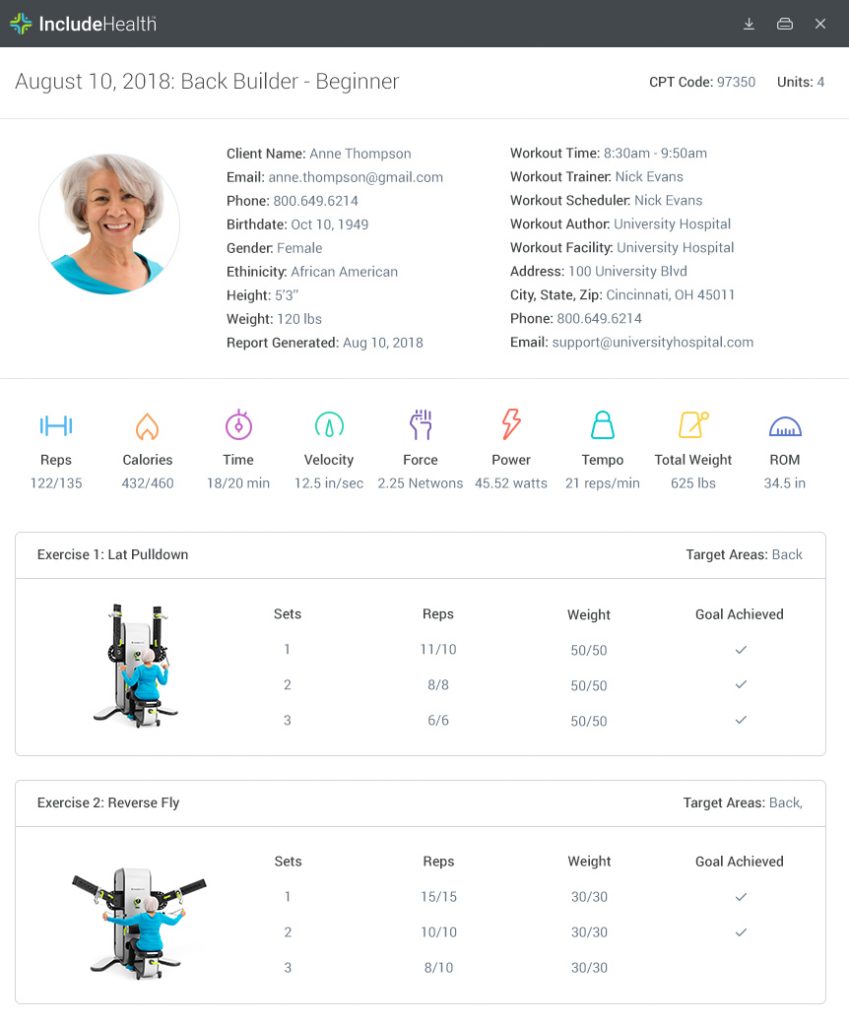

The Access Strength equipment sends critical fitness data to a cloud platform tracking the progress made by each user.
Together, the software and the hardware behind IncludeHealth make for the most inclusive physical exercise equipment I have ever seen in my life.
Although the IncludeHealth team is currently focused on deploying their solution to hospitals, rehabilitation centers and senior community centers, make no mistake: the IncludeHealth platform is something that could benefit every gym and training facility in the world.
With IncludeHealth, you can create a personalized workout plan from the comfort of your home. When you reach the gym, by simply tapping your RFID tag to a sensor on the machine, you get access to your custom workout schedule. Even more revolutionary, the automated assistant will show you how to perform an exercise, track your every movement and record your workout session on the cloud.
In sum, IncludeHealth is the future of physical exercise as we know it.
Watch this emotional testimonial from one of the IncludeHealth users who can finally exercise and live a better life.
Achieving an inclusive, multi-channel revolutionary platform was not an easy task.
Ryan Eder and his team have spent more than 12 years, countless sleepless nights and significant capital to make this a reality.
As we all know, ideas are cheap – everyone has one. But to execute against such an ambitious goal takes discipline, hard work and significant changes in direction.
The journey to build this phenomenal platform is where executives can learn the most valuable lessons.
Below are the 3 most critical lessons I learned from Ryan’s story about building a great technology product in the healthcare space.


An earlier prototype of the Access Strength equipment.
Ryan came up with the idea behind IncludeHealth when he saw a disabled person struggling to exercise at a local gym in Cincinnati, Ohio. At the time, Ryan was in college studying industrial design at University of Cincinnati. He wrote his senior thesis on what, years later, would become the Access Strength device.
Things didn’t pick up for IncludeHealth right away. The idea was shelved for seven years while Ryan worked at various companies in Cincinnati, designing products for other prestigious companies: Logitech, Sirius, Microsoft, Nike and Procter & Gamble.
In 2013, he submitted his design idea for the Access Strength device to one of the most prestigious competitions in the field receiving Gold at ‘Best in Show’ and ‘People’s Choice’ in 2007 International Design Excellence Awards. To Ryan’s and everyone else’s amazement, his submission received the top award in his category for industrial design, a prestigious distinction won in subsequent years by well-recognized companies: Apple, Tesla, Nike and Microsoft. When Ryan speaks of that experience, his eyes light up. You can sense the excitement and well deserved pride in his voice:
‘Winning the award was like basically winning the Best Picture at the Oscars. It was just unbelievable. Then I got invited to go overseas, go around the country and start sharing this idea, which was just renderings on a piece of paper. I got emails and phone calls from different industry specialists asking if they could help me build this product, asking where is it, where can I get it? So that creates a very real pressure.’
Having an idea and turning into something real, took far more time and execution. It would take Ryan and his team three more years to create a final product. More importantly, it also required going through many iterations, getting user feedback, conducting massive quantities of research into accessibility rules, tweaking design and more.
I asked Ryan about the early days of working on the first prototype. Hearing this story, there is another clear lesson to be learned: a company should never give up on a good idea but instead keep redefining until the best product is finally built:
‘The first prototype, you would laugh. I have pictures of all earlier prototypes, and they look hilarious. This is how development goes. We built the street prototypes and then we built one that had these initial mechanisms together.’
From 2013 to 2016, the team worked tirelessly to refine the design for the physical prototype. This was no joking matter. According to the Americans with Disability Act, there are over 120 guidelines and standards for accessible design. According to Ryan Eder – The Access Strength device follows all of them.
To work on any idea, on and off, for almost a decade before a final product is built, takes perseverance, courage and real determination.
In a world in which we are constantly trained to be primarily concerned with instant gratification, Ryan’s story stands out from the crowd.
It shows that sometimes, if you really believe in something, you really have to follow your dream to get there.
However long that may take you.


Ryan Eder receiving feedback from a person with disabilities who would be using the Access Strength equipment on a regular basis.
You can have the best idea in the world, but sometimes the execution of that idea leads to disastrous results. CBInsights has a phenomenal article on 132 corporate innovation designs gone bad.
At the core of ensuring you are building the right product for the right audience at the right time is the process of collecting, summarizing and implementing user feedback. Many companies claim they do extensive user feedback, but we know better. Unfortunately, user insight is often used in name only, with internal stakeholders simply defining what’s best for a product.
IncludeHealth’s approach to user feedback was different from the beginning.
Not only did they seek feedback from potential users, they’ve actually taken their machine out of the lab to places where users can provide live feedback on the design and functionality of the equipment. To do this with a piece of equipment weighing nearly 700 pounds, is no small feat! Ryan’s team took the equipment to trade shows, hospitals and senior living communities.
This is what Ryan recalls about this exercise: ‘Everybody got excited. People got emotional. Because it was the first time they could actually interact with an equipment.’
Later, when IncludeHealth launched its digital platform and expanded to provide a digital solution for physical therapists and physicians, the company once again worked hard to gather feedback from a wide variety of stakeholders – especially those who will use the platform on a daily basis. As Ryan pointedly states: ‘customers are our partners.’ For this reason, users of the final platform always have a seat at the table when it comes to improving the IncludeHealth platform:
‘We’re getting all these flows of information back and saying “oh could we do this? Or could we do this?” We’re looking to expand this. So you get that information and then you digest it, synthesize it, and then figure out what kind of makes sense and what platform.’
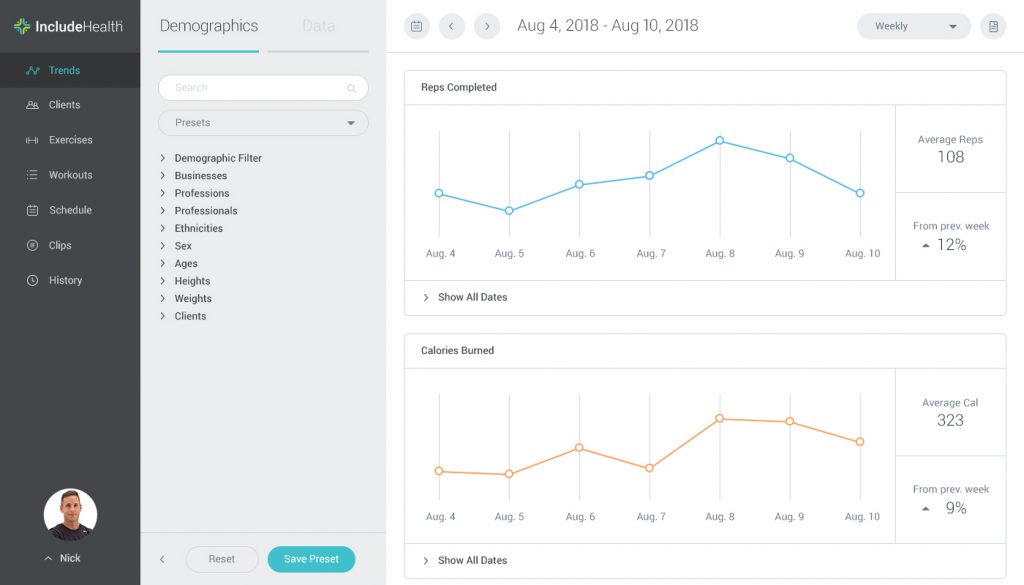

The IncludeCloud platform was built with different audiences in mind. In this web view, a trainer can monitor their client’s performance over time.
When companies actually take user feedback to heart in product development – beautiful things happen.
You create a community. Users share their experiences with you not just for the sake of feedback, but also because they’re helping themselves and everyone else using a technology.
The IncludeHealth platform has undergone countless iterations over the years. And, undoubtedly, many more iterations will come.
This is the crux of staying on top of the innovation wave: you need to constantly improve your platform by leveraging your customers to make the best possible product.
Watch this short video explaining exactly how IncludeHealth equipment works. And this took many years to build, refine and perfect – a Herculean task which is clearly paying dividends now to the IncludeHealth team.
The last important lesson I learned from Ryan is a simple one: never stop innovating.
But there is nothing simple about actually innovating on a continuous basis.
In fact, reshaping your company, culture and product lines, always changing to stay on top of the latest trends is, by far, the hardest thing any leader can do.
Take IncludeHealth for example.
What started with the design of a physical exercise equipment is now a robust solution with an amazing digital interface that controls an approximately 700-pound equipment from the cloud. If you think designing a sleek, modern and intuitive physical equipment is hard, wait till you try to create a digital interface that can manage it remotely.
And that’s exactly what IncludeHealth did. The IncludeCloud is the very definition of an exceptional digital platform with different user groups leveraging it for different goals. As an end user, I can go to IncludeCloud to see my past workout sessions, stats about my performance over time, schedule a workout session and much more. Physicians can go online to monitor all their patients, get insights into the overall progress of a patient, and adjust workout schedules to streamline their patient’s care plans.
IncludeHealth innovated well beyond improving their core products. In fact, they underwent a complete rebranding exercise early this year. Until 2018, IncludeHealth was known as IncludeFitness. This reflected the original goal of the equipment: to help patients get in better shape. However, as their digital platform evolved to become a fully-fledged data analytics platform for payers, physicians and patients – it became far more than just a fitness equipment. It became a platform to measure and improve the health of all the users leveraging this platform.
As Ryan puts it:
‘As this technology evolved into a digital health platform, we realized that fitness was just a small portion of what we were doing. We were going into healthcare, we were going across the entire continuum. Our brand did not reflect the evolution of our technology. So slight shift to include health. More representative of what we are doing now and representative of where we want to go.’
Performing a complete rebranding to be more inclusive of your target audience and more reflective of the company mission is no small task. It takes courage, effort and money to undergo such an effort. In the case of IncludeHealth, it made complete sense. Twelve years later, this company is significantly more than just a fitness product. It’s a holistic healthcare management platform which able-bodied and disabled people alike can really leverage to improve their quality of life and achieve their fitness objectives.
The IncludeHealth company has come a long way from senior college thesis to, in my opinion, the most advanced healthcare platform in the world.
Even so, it has a long way to go still before it becomes the powerhouse name it deserves to be in the industry.
Whereas the platform itself can reach mass appeal among virtually every person going to a gym in the world, the company’s current primary focus is on the physical therapy market, which may be more difficult to break into and quickly expand . One in five Americans have a gym membership at one of the 40,000 gyms all over the country.
For now, the company remains strictly B2B which unfortunately means that people who can afford to buy the machine for their home gyms cannot do it. There are approximately 25 million Americans today who have a home gym ranging from a small room to a fully equipped gym.
Although the company is gathering massive amounts of data about patients’ workout routines, there are currently no plans to share that data with pharma or technology companies who may be in the business of innovating in the same space with and in complementary ways to the IncludeHealth business. Even so, Ryan was quick to note that he is ‘always looking for the right partners.’
The IncludeHealth digital interface provides a myriad of data points about customers’ workout sessions, but IncludeCloud, where the data is stored, fails short of actually turning individual data points into insights for digital users. As we all know, the power of analytics is to make sense of data and to discover meaningful trends which can then be turned into powerful and actionable insights. As one author notes, “Insights provide the “ah-ha” light bulb’ which then leads to behavior changes and adjustments which have long term positive impacts for people using a product”.
Last but not least, the company can definitely benefit from building a mobile application that would easily allow users to adjust their fitness work out session on the go. IncludeHealth does have a mobile responsive website though.
Interested in learning about other startups that are revolutionizing the healthcare industry? Check out our guide to 31 Healthcare Startups to Watch for in 2018.